Radiological Dose Assessment of the Landfill Disposal of Consumer Products Containing Naturally Occurring Radioactive Materials in South Korea
Abstract
:1. Introduction
2. Materials and Methods
2.1. CPs Containing NORMs
2.2. Scenario Description
2.2.1. Scenario of Landfill Disposal
2.2.2. Scenario of Incineration
2.3. Methodology of RESRAD-ONSITE
2.4. Methodology of RESRAD-OFFSITE
2.5. Methodology of HotSpot
2.6. Governing Equation of RESRAD and HotSpot
- x, y, and z = downwind, cross-wind, and vertical directions, and
- Px, Py, Pz = diffusivity in x-, y- and z-directions, respectively.
- T = time-integrated atmospheric concentration (Ci-s)/(m3);
- R = source term (Ci);
- H = effective release height (m);
- = radioactive decay constant (s–1);
- x = downwind distance (m);
- y = crosswind distance (m);
- z = vertical axis distance (m);
- = standard deviation of integrated concentration distribution in the crosswind direction (m);
- = standard deviation of the integrated concentration distribution in the vertical direction (m);
- u = average wind speed at the effective release height;
- L = inversion layer height (m);
- PDF(x) = plume depletion factor.
2.7. Methodology of NORMALYSA
- total deposition of radionuclides from the atmosphere to the receptor area (Bq/year);
- = transfer of radionuclides to the receptor area with irrigation water (Bq/year);
- = radionuclide inventory in the deep zone of soil (Bq);
- transfer coefficient of radionuclide from deep soil zone to rooting zone to compensate for erosion losses from the rooting zone (1/year);
- transfer coefficient of radionuclide from the deep soil to the rooting zone due to bioturbation (1/year);
- transfer coefficient of radionuclides from the root zone to the deep zone by leaching (1/year);
- transfer coefficient of radionuclides from the rooting zone due to the erosion process (1/year);
- transfer coefficient of radionuclide from the rooting soil to the deep zone due to bioturbation (1/year).
- concentration in outdoor air from resuspension (Bq/m3);
- radionuclide concentration in the receptor topsoil (Bq/kg.DW/m3);
- concentration of dust in atmospheric air (Kg.DE/m3).
- Total dose from external exposure;
- = total dose from inhalation exposure.
3. Results
4. Discussion
5. Conclusions
Author Contributions
Funding
Institutional Review Board Statement
Informed Consent Statement
Data Availability Statement
Conflicts of Interest
References
- International Atomic Energy Agency, Management of NORM Residues-IAEA-TECDOC-1712; IAEA: Vienna, Austria, 2013.
- Dwipayana, C.A.W.; Moersidik, S.S.; Pratama, M.A. Estimation radiation dose from operation of petroleum NORM waste disposal in landfill using TSD-DOSE. J. Phys. Conf. Ser. 2020, 1572, 012031. [Google Scholar] [CrossRef]
- Jeong, J.; Ko, N.Y.; Cho, D.K.; Baik, M.H.; Yoon, K.H. Estimation of exposure doses for the safe. Radiat. Prot. Dosim. 2018, 181, 394–402. [Google Scholar] [CrossRef] [PubMed]
- Jang, M.; Chung, K.H.; Lim, J.M.; Ji, Y.Y.; Kim, C.J.; Kang, M.J. Analysis and evaluation for consumer goods containing NORM in Korea. Appl. Radiat. Isot. 2017, 126, 293–295. [Google Scholar] [CrossRef] [PubMed]
- International Atomic Energy Agency. Radiation Safety for Consumer Products; IAEA Safety Standard Series No: SSG-36; IAEA: Vienna, Austria, 2016. [Google Scholar]
- United State Nuclear Regulatory Commission (US NRC). Disposals of Very Low-Level Waste Under; US NRC: Rockville, MA, USA, 2002; Volume 10. [Google Scholar]
- Hui-Gyeong, K.; Sang-Wook, H.; Su-Ri, P.; Byung-Jick, K. Safety assessment on the incineration disposal of regulation exempt waste by RESRAD code. J. Radiol. Sci. Technol. 2018, 41, 67–73. [Google Scholar] [CrossRef]
- Mora, J.C.; Baeza, A.; Robles, B.; Sanz, J. Assessment for the management of NORM wastes in conventional hazardous and nonhazardous waste landfills. J. Hazard. Mater. 2016, 310, 161–169. [Google Scholar] [CrossRef] [PubMed]
- Grupen, C. Radiation protection. In Handbook of Particle Detection and Imaging; Springer: Berlin/Heidelberg, Germany, 2012; pp. 203–235. [Google Scholar] [CrossRef]
- Yoon, S.-J. South Korea’s experience with smart infrastructure services: Integrated solid waste management. Inter-Am. Dev. Bank 2020, 4, 421–425. [Google Scholar]
- Liu, A.; Ren, F.; Lin, W.Y.; Wang, J.Y. A Review of Municipal Solid Waste Environmental Standards with a focus on Incinerator Residues. Int. J. Sustain. Built Environ. 2015, 4, 165–188. [Google Scholar] [CrossRef] [Green Version]
- Harto, C.B.; Smith, K.P.; Kamboj, S.; Quinn, J.H. Radiological dose and risk assessment of landfill disposal of technologically enhanced naturally occurring radioactive materials (TENORM) in north Dakota. Argonne Natl. Lab. 2014. [Google Scholar] [CrossRef]
- Njinga, R.L.; Tshivhase, V.M. Use of RESRAD-Onsite 7.2 code to assess environmental risk around tudor shaft mine tailing sites. Environ. Nat. Resour. Res. 2018, 8, 138–147. [Google Scholar] [CrossRef]
- Ziajahromi, S.; Khanizadeh, M.; Nejadkoorki, F. Using the RESRAD code to assess human exposure risk to 226Ra, 232th, and 40K in Soil. Hum. Ecol. Risk Assess. 2015, 21, 250–264. [Google Scholar] [CrossRef]
- Kontol, K.M.; Ahmad SH, S.S.; Omar, M. Radiological Impact Assessment for Landfill Disposal of NORM Wastes in Malaysia; Malaysian Nuclear Agency (Nuclear Malaysia): Bangi, Malaysia, 2007; pp. 355–359. [Google Scholar]
- Oh, D.-Y.; Shin, K.-J.; Jeon, J.-S. Measurement and spatial analysis of Uranium-238 and Radon-222 of soil in Seoul. J. Soil Groundw Environ. 2017, 22, 33–40. [Google Scholar] [CrossRef] [Green Version]
- Mujuni, R. Estimation of Radiological Impact from Uranium Mining and Milling Operations at Mkuju River Project in Tanzania; KINGS: Ulsan, Korea, 2020. [Google Scholar]
- Faisalabad, R.C. Modeling Radiation Doses for a Hypothetical Contaminated Site Using RESRAD-OFFSITE Code Faisalabad, Haripur University, Haripur, Pakistan; Haripur University: Haripur, Pakistan, 2018. [Google Scholar]
- Mathuthu, M.; Kamunda, C.; Madhuku, M. Modelling of radiological health risks from gold mine tailings in Wonderfonteinspruit catchment area, South Africa. Int. J. Environ. Res. Public Health 2016, 13, 570. [Google Scholar] [CrossRef] [PubMed] [Green Version]
- Adliene, D.; Skridaila, N.; Motiejunas, S.; Meurville, C. Modelling of Carbon-14, Iodine-129 and Cesium-137 releases from near surface radioactive waste disposal and their impact on environment and humans. Kerntechnik 2007, 72, 268–273. [Google Scholar] [CrossRef]
- ICRP. International Commission on Radiological Protection; Recommendations of the Radiological Protection Publication 26; ICRP: New York, NY, USA, 1977; Volume 26, pp. 1–87. [Google Scholar]
- Radiation, M. Annals of the ICRP Annals of the ICRP Members of the Main Commission of the ICRP; ICRP: New York, NY, USA, 2000; Volume 30. [Google Scholar]
- Sowby, F.D. Annals of the ICRP. Ann. ICRP 1981, 6, 1–2. [Google Scholar] [CrossRef]
- Yu, C.; Zielen, A.J.; Cheng, J.J.; LePoire, D.J.; Gnanapragasam, E.; Kamboj, S.; Arnish, J.; Wallo, A., III; Williams, W.A.; Peterson, H. User’s Manual for RESRAD Version 6. 2001. Available online: https://resrad.evs.anl.gov/docs/resrad6.pdf (accessed on 5 July 2021).
- Yu, C. User’s Manual for Resrad-Offsite Code Version 4; Argonne National Laboratory Lemont: Lemont, IL, USA, 2020; Volume 4. [Google Scholar]
- Edson, R.A.; Nelson, M.A.; Joao, B.T.R.; Ivana, B.M.C.; Liliane, F.B.; Greice, F.S.; Michel, M.M.; Veronica, V.R. HotSpot Health Physics Codes used as A Tool for Managing Excess Risk on Radiological Emergencies. pp. 1–7. Available online: https://inis.iaea.org/search/search.aspx?orig_q=RN:43052715 (accessed on 5 July 2021).
- Avila, R.; Johansson, E.; Bugai, D.; Koliabina, D.; Falicia, A.B. User’s Manual for NORMALYSA v. 2. 1 Mathematical Models and Parameters. 2018. Available online: https://www.researchgate.net/publication/326111484_User’s_manual_for_NORMALYSA_v21_Description_of_Program_Module_Libraries_Mathematical_Models_and_Parameters (accessed on 5 July 2021).
- Bugai, D.A.; Avila, R. Radionuclide Transport and Dose Calculations for Zapadnoe Uranium Mill Tailings Test Case Using NORMALYSA Tool. 2016. Available online: https://www.researchgate.net/publication/290448866_Radionuclide_transport_and_dose_calculations_for_Zapadnoe_uranium_mill_tailings_test_case_using_NORMALYSA_tool (accessed on 5 July 2021).
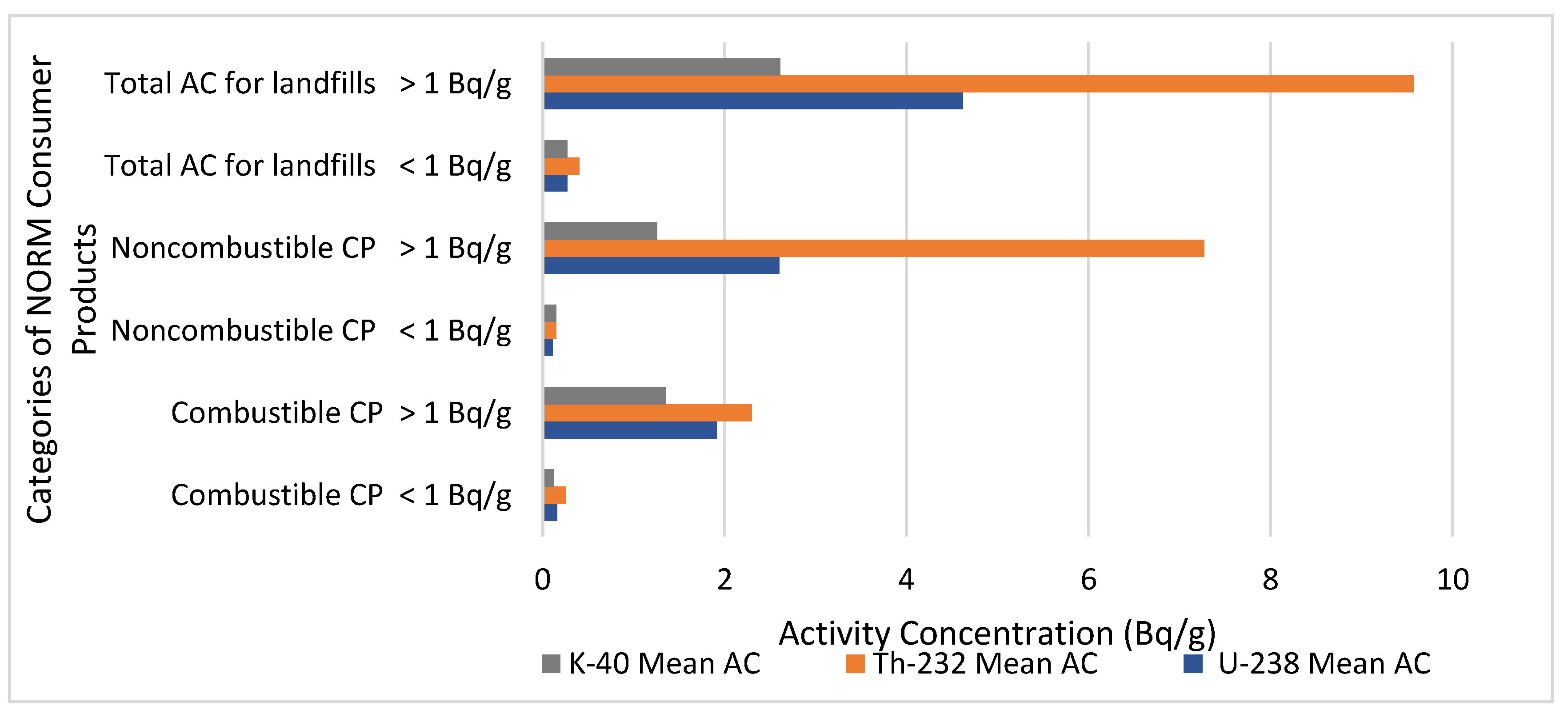
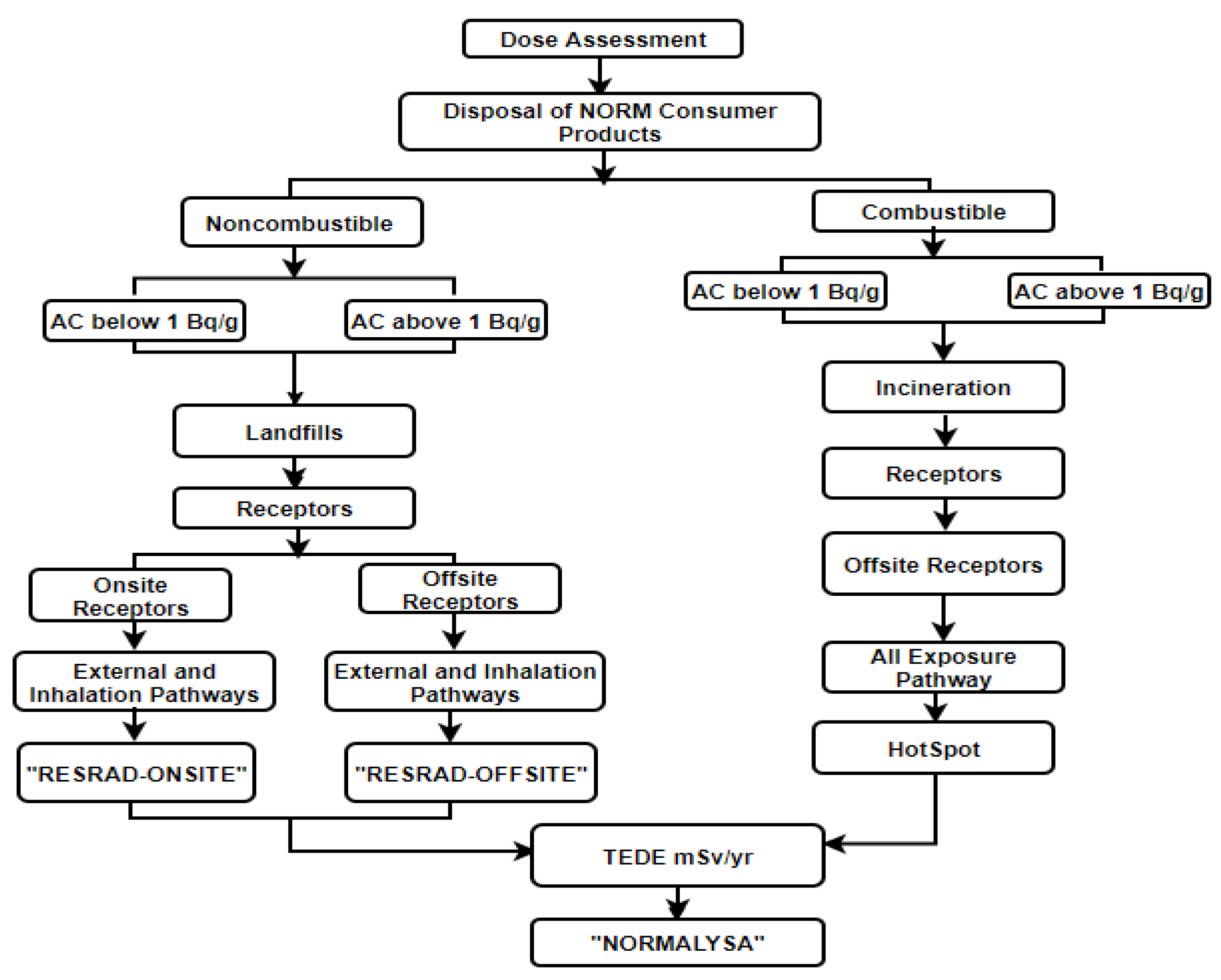


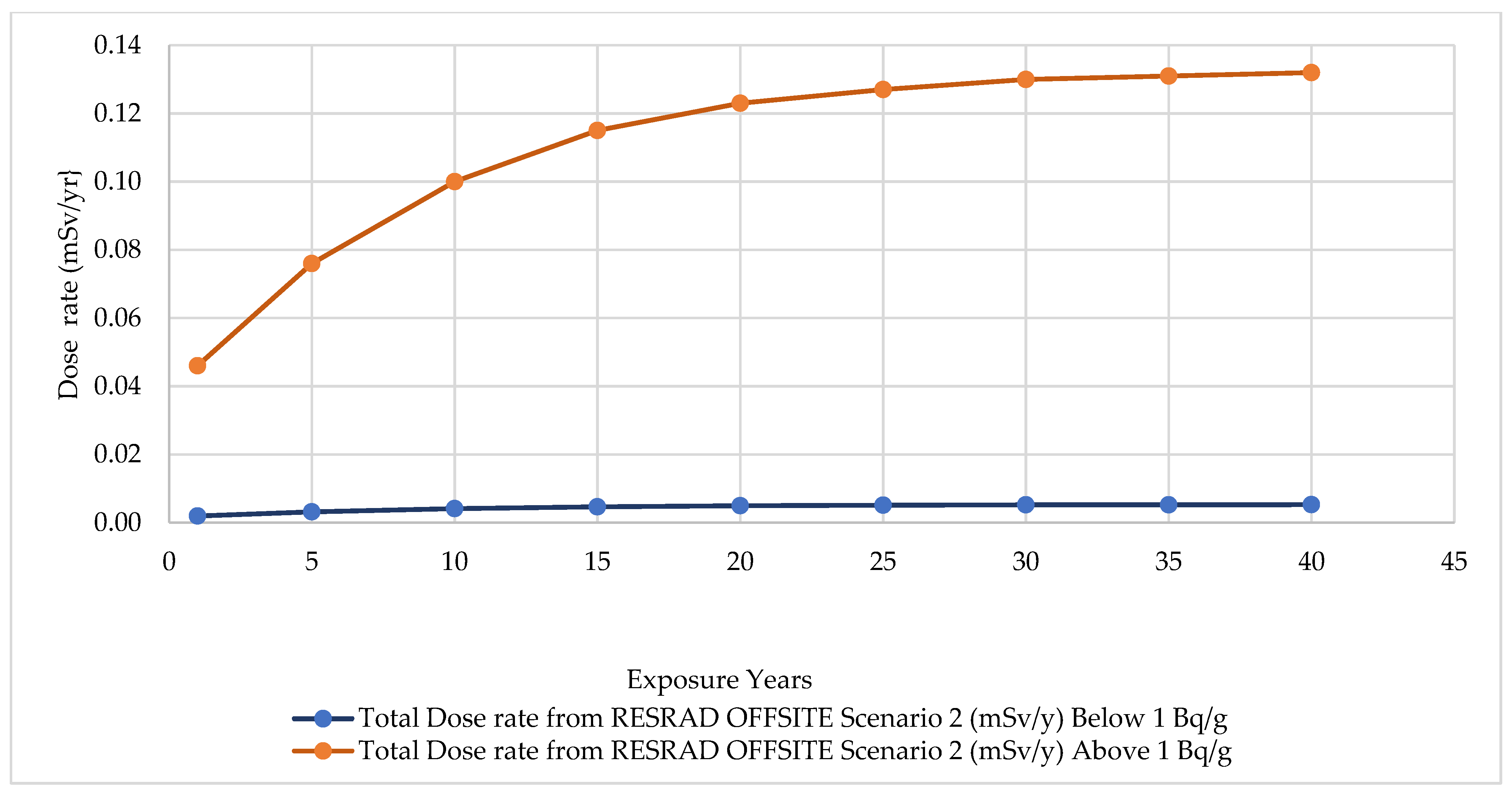
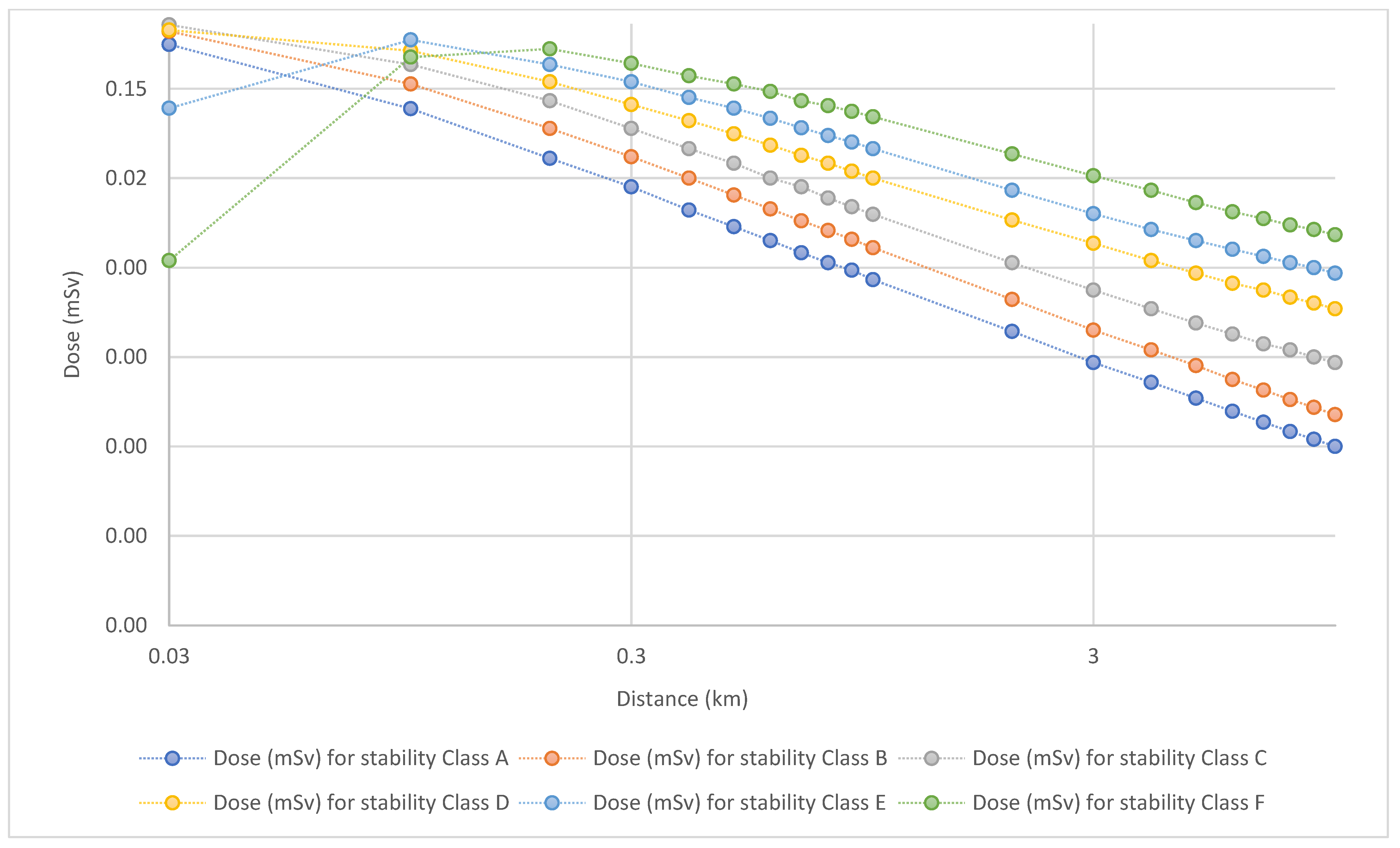
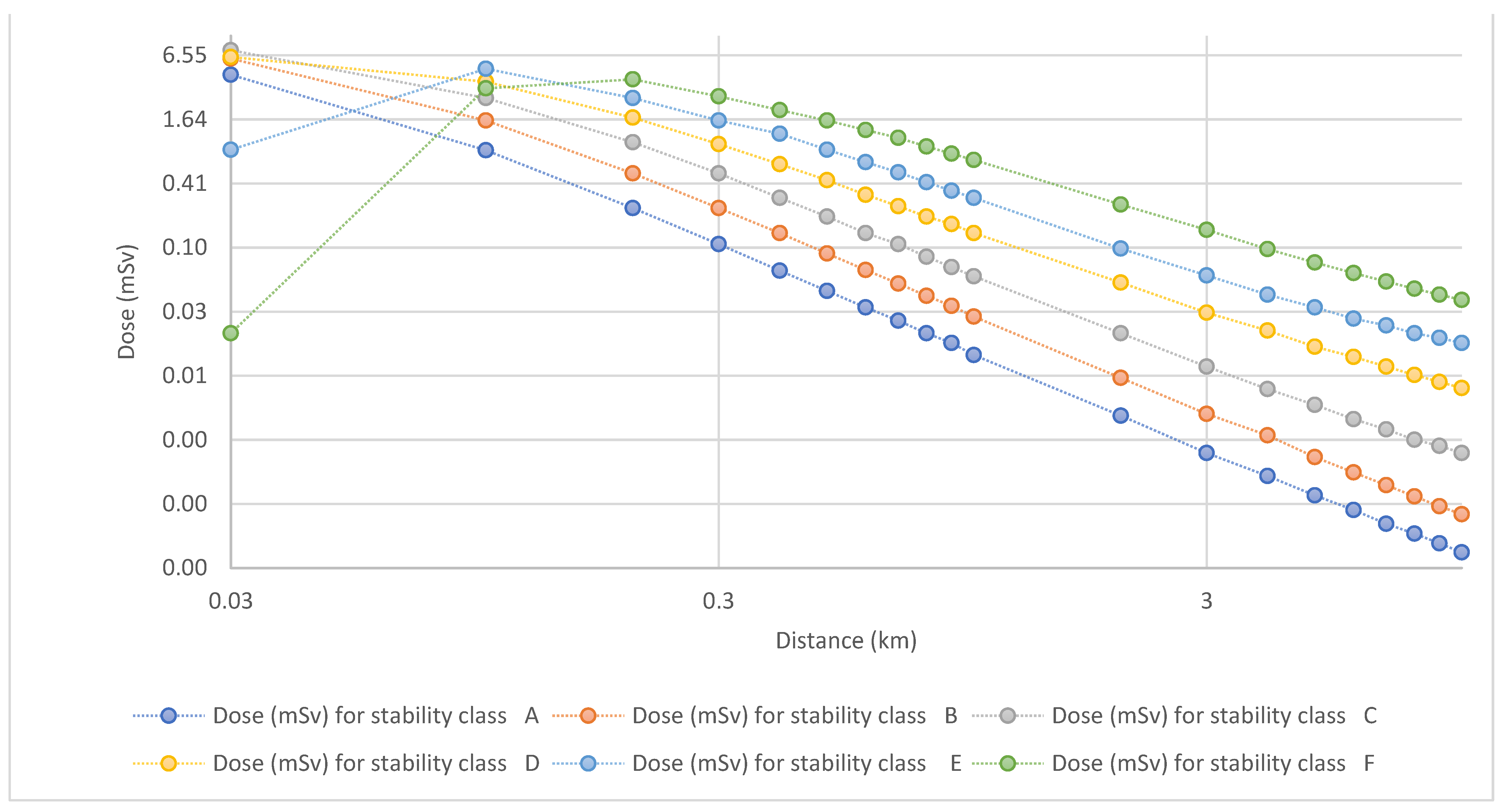
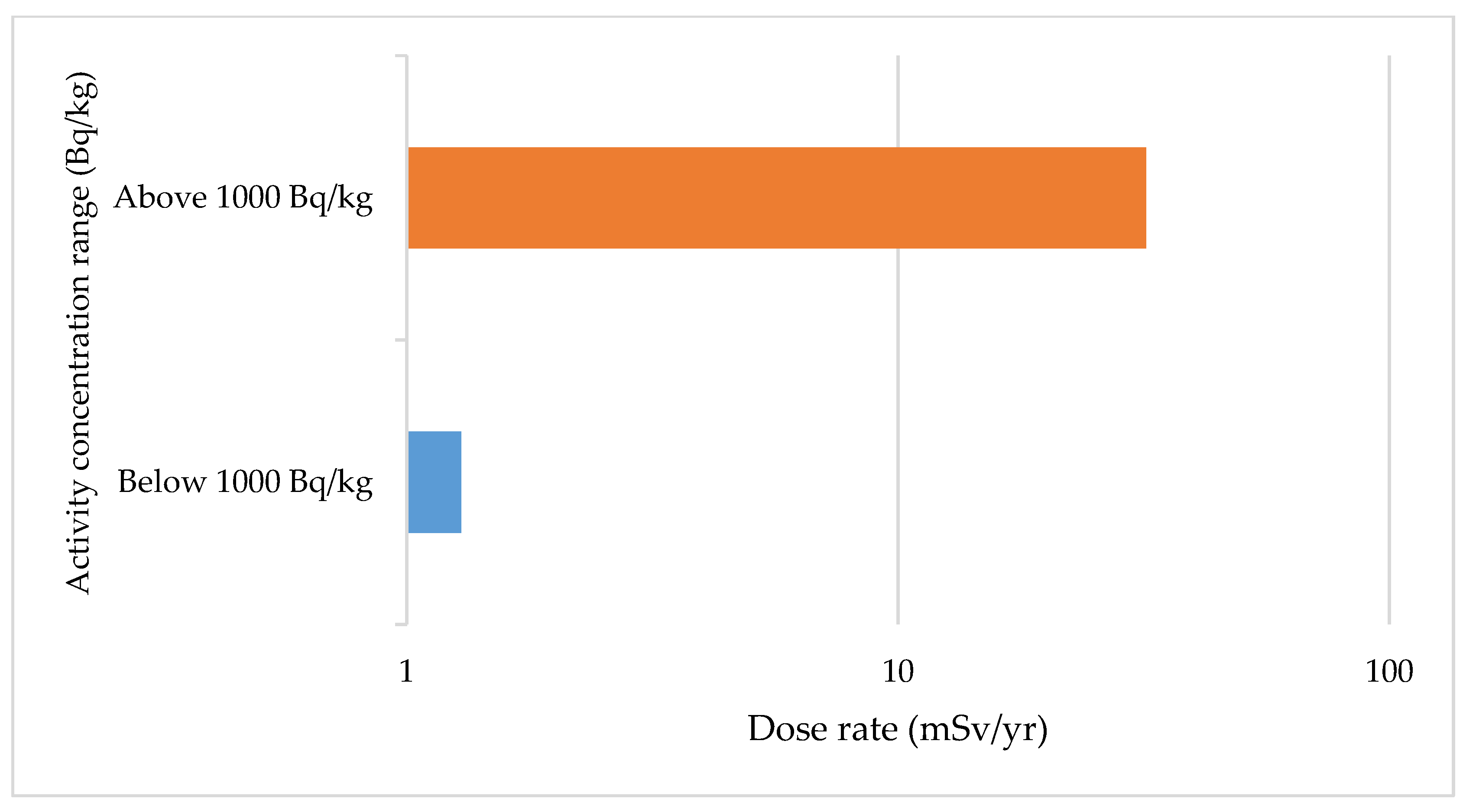
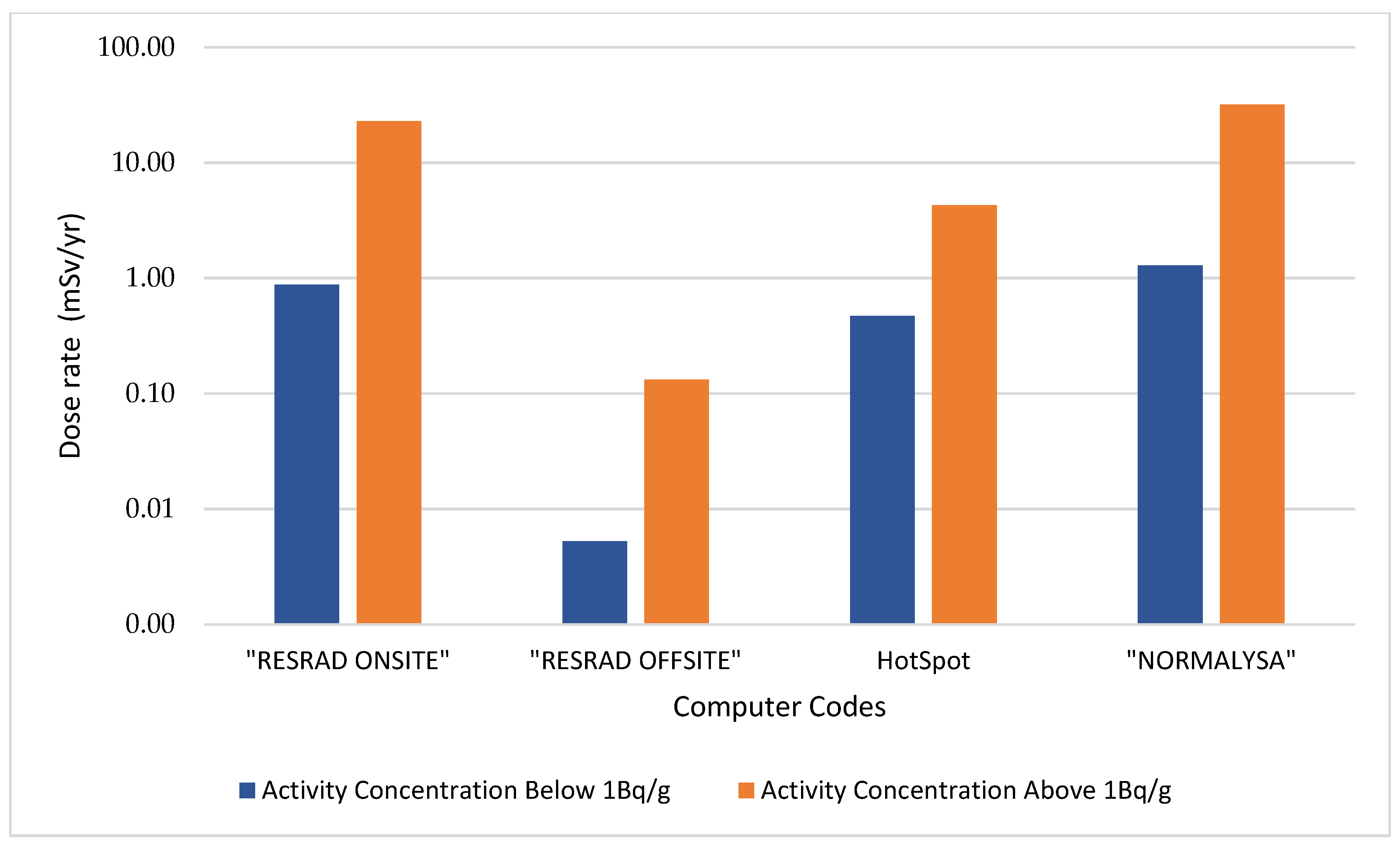
| Specific Activity Concentration (Bq/kg) | Total Activity (Bq) | |||||
|---|---|---|---|---|---|---|
| Categories of CP | 238U | 232Th | 40K | 238U | 232Th | 40K |
| Combustible (below 1000 Bq/kg) | 164 | 226 | 125 | 5.72 × 106 | 7.86 × 106 | 4.36 × 106 |
| Combustible (above 1000 Bq/kg) | 1917 | 2320 | 1358 | 6.68 × 107 | 8.088 × 107 | 4.73 × 107 |
| Noncombustible (below 1000 Bq/kg) | 114 | 153 | 150 | 3.97 × 106 | 5.33 × 106 | 5.23 × 106 |
| Noncombustible (above 1000 Bq/kg) | 2607 | 7250 | 1310 | 9.09 × 107 | 2.53 × 108 | 4.41 × 107 |
| Total AC for landfills (below 1000 Bq/kg) | 278 | 379 | 275 | 9.69 × 106 | 1.32 × 107 | 9.59 × 106 |
| Total AC for landfills (above 1000 Bq/kg) | 4638 | 9570 | 2668 | 1.62 × 108 | 3.33 × 108 | 9.15 × 107 |
| Modelling Steps | Description |
|---|---|
| Context model options | To define model structure |
| Time series parameters | To specify parameters models |
| Simulation | To carry out calculation |
| Charts, tables, and reports | To analyze and report results |
| Codes | Models | Advantage | Disadvantage |
|---|---|---|---|
| RESRAD-ONSITE | Gaussian plume model | Evaluates radiological dose and risk to onsite receptors | Low wind speed condition, no memories of previous emission |
| RESRAD-OFFSITE | Gaussian plume model | Evaluates radiological dose and risk to offsite receptors | Breaks down during low wind speed condition |
| HotSpot | Atmospheric dispersion model | Evaluates incident involving radioactive materials | Estimate the short range (less than 10 km) |
| NORMALYZA | Gaussian plume model | Simulate radionuclide transport from contaminated land to relevant receptors | Low wind speed condition, no memories of previous emission |
| Input Parameter | Value | Source |
|---|---|---|
| Concentration below 1 Bq/g | NSSC | |
| 238U | 0.20 Bq/g | |
| 232Th | 0.40 Bq/g | |
| 40K | 0.27 Bq/g | |
| Concentration above 1 Bq/g | NSSC | |
| 238U | 4.62 Bq/g | |
| 232Th | 9.57 Bq/g | |
| 40K | 2.61 Bq/g | |
| Exposure duration | 30 years | RESRAD default |
| Area of the contamination zone | 659 m2 | Korea statistics, 2018 |
| Density of cover material | 1.5 g/cm3 | RESRAD default |
| Cover depth | 0 m | RESRAD default |
| Thickness of the contaminated zone | 2 m | RESRAD default |
| Density of the contaminated zone | 1.5 g/cm3 | RESRAD default |
| Inhalation rate for onsite resident | 8400 m3/year | RESRAD default |
| Inhalation rate for industrial workers | 11,400 m3/year | RESRAD default |
| Cover radon diffusion coefficient | 0.000002 m2/s | RESRAD default |
| Contaminated radon diffusion coefficient | 0.000002 m2/s | RESRAD default |
| Distribution coefficient of the contaminated zone | 100 cm3/g | RESRAD default |
| Transport factors | ||
| 238U | 5.5 cm3/g | |
| 232Th | 60,000 cm3/g | RESRAD default |
| 40K | 50 cm3/g | |
| Release height | 2 m | Assumed value |
| Outdoor fraction | 0.25 | RESRAD default |
| Indoor fraction | 0.5 | RESRAD default |
| Parameters | Values |
|---|---|
| Source material below and above 1000 Bq/kg | AC of 238U, 232Th, and 40K |
| Receptors height | 5 m |
| Sample time | 40 min |
| Effective release height | 7 ft |
| Atmospheric stability | Sun high in the sky |
| Wind speed | 2.24 mph |
| Wind direction | 270 |
| Wind speed | 10 m/s |
| Stability class | A |
| Breathing rate | 3.33 × 10−4 m3/s |
| Input Parameter | Value | Reference |
|---|---|---|
| Activity concentration | Same as RESRAD | NSSC |
| Concentration of radionuclides in outdoors air | ||
| 238U | 6.0 × 10−8 Bq/m3 | |
| 232Th | 2.0 × 10−7 Bq/m3 | [28] |
| 40K | 2.9 × 10−10 Bq/m3 | |
| Fraction of the year a person stays within the contaminated site | 0.25 | RESRAD default |
| Soil bulk density | 1.5 g/cm3 | RESRAD default |
| Ambient external dose rate outdoors | 1.2 × 10−7 Sv/h | NORMALYSA default |
| Conversion factor from ambient to effective dose | 0.6 | NORMALYSA default |
| Dose coefficient for effective dose by inhalation | ||
| 238U | 8.0 × 10−8 | |
| 232Th | 1.1 × 10−4 | |
| 40K | 2.9 × 10−9 | NORMALYSA default |
| Time of calculation | 1000 years | Same as RESRAD |
| Area of contaminated site | 659 m2 | Korea Statistics 2018 |
Publisher’s Note: MDPI stays neutral with regard to jurisdictional claims in published maps and institutional affiliations. |
© 2021 by the authors. Licensee MDPI, Basel, Switzerland. This article is an open access article distributed under the terms and conditions of the Creative Commons Attribution (CC BY) license (https://creativecommons.org/licenses/by/4.0/).
Share and Cite
Nandutu, M.; Kim, J. Radiological Dose Assessment of the Landfill Disposal of Consumer Products Containing Naturally Occurring Radioactive Materials in South Korea. Appl. Sci. 2021, 11, 7172. https://doi.org/10.3390/app11157172
Nandutu M, Kim J. Radiological Dose Assessment of the Landfill Disposal of Consumer Products Containing Naturally Occurring Radioactive Materials in South Korea. Applied Sciences. 2021; 11(15):7172. https://doi.org/10.3390/app11157172
Chicago/Turabian StyleNandutu, Mercy, and Juyoul Kim. 2021. "Radiological Dose Assessment of the Landfill Disposal of Consumer Products Containing Naturally Occurring Radioactive Materials in South Korea" Applied Sciences 11, no. 15: 7172. https://doi.org/10.3390/app11157172
APA StyleNandutu, M., & Kim, J. (2021). Radiological Dose Assessment of the Landfill Disposal of Consumer Products Containing Naturally Occurring Radioactive Materials in South Korea. Applied Sciences, 11(15), 7172. https://doi.org/10.3390/app11157172






